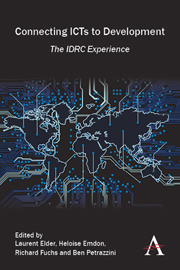Book contents
- Frontmatter
- Contents
- Acknowledgments
- Introduction Part I From Heresy to Orthodoxy: ICT4D at IDRC
- Introduction Part II From Beginning to End to Beginning Again
- Chapter 1 Catalyzing Access through Social and Technical Innovation
- Chapter 2 Catalyzing Access via Telecommunications Policy and Regulatory Research
- Chapter 3 Access to Knowledge as a New Paradigm for Research on ICTs and Intellectual Property
- Chapter 4 ICTs and Social Inclusion
- 5 Access and Usage of ICTs by the Poor (Part I)
- Chapter 6 Local Economic Opportunities and ICTs: How ICTs Affect Livelihoods (Part II)
- Chapter 7 Research on eHealth across Health Systems: Contributions to Strengthen a Field
- Chapter 8 Making the Grade: The Role of ICTs in Providing Access to Knowledge
- Chapter 9 E-Government for Development: ICTs in the Public Sector and the Evolving Citizen–Government Relationship
- Chapter 10 Innovations in Evaluating ICT4D Research
- Chapter 11 Conclusions: A Decade of Innovation that Matters
- Epilogue Into the Future: New Opportunities and Threats in a Global Networked Society
- Author Biographies
Chapter 4 - ICTs and Social Inclusion
from Introduction Part II - From Beginning to End to Beginning Again
Published online by Cambridge University Press: 05 March 2014
- Frontmatter
- Contents
- Acknowledgments
- Introduction Part I From Heresy to Orthodoxy: ICT4D at IDRC
- Introduction Part II From Beginning to End to Beginning Again
- Chapter 1 Catalyzing Access through Social and Technical Innovation
- Chapter 2 Catalyzing Access via Telecommunications Policy and Regulatory Research
- Chapter 3 Access to Knowledge as a New Paradigm for Research on ICTs and Intellectual Property
- Chapter 4 ICTs and Social Inclusion
- 5 Access and Usage of ICTs by the Poor (Part I)
- Chapter 6 Local Economic Opportunities and ICTs: How ICTs Affect Livelihoods (Part II)
- Chapter 7 Research on eHealth across Health Systems: Contributions to Strengthen a Field
- Chapter 8 Making the Grade: The Role of ICTs in Providing Access to Knowledge
- Chapter 9 E-Government for Development: ICTs in the Public Sector and the Evolving Citizen–Government Relationship
- Chapter 10 Innovations in Evaluating ICT4D Research
- Chapter 11 Conclusions: A Decade of Innovation that Matters
- Epilogue Into the Future: New Opportunities and Threats in a Global Networked Society
- Author Biographies
Summary
According to a growing number of reports, conferences, academic papers and popular media sources, more and more people are living in an “information society.” Wikipedia, arguably an archetypal result of the information society, defines this term as “a society where the creation, distribution, diffusion, use, integration and manipulation of information is a significant economic, political and cultural activity.”
But what does an information society look like? Does it look, behave and respond the same way for everyone? Who is part of the information society and who is not? How does participation vary by gender, ability and literacy? How can information and communications technologies (ICTs) worsen existing inequities and further marginalize disadvantaged groups? As with any society, an information society is composed of individuals and groups occupying a shared territory – a virtual one, in this case – and is characterized by relationships, expectations, institutions and varying levels of influence and participation. This chapter examines two central questions that are closely linked: how can inequities of access to ICTs be redressed and how can access to ICTs potentially facilitate or inhibit social inclusion?
It would be foolish to assume that just using ICTs alone could redress inequities that persist within and among these groups. There are myriad factors and complex dependencies underlying if, how and to what extent social exclusion is experienced. Similarly, the ways in which social inclusion can be made possible through the use of ICTs are equally complex, interdependent and non-linear in nature.
- Type
- Chapter
- Information
- Connecting ICTs to DevelopmentThe IDRC Experience, pp. 91 - 116Publisher: Anthem PressPrint publication year: 2013

